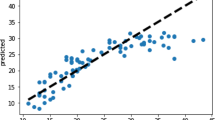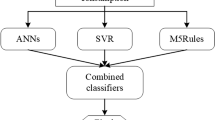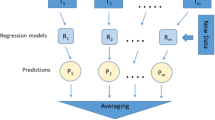Abstract
Building energy consumption is heavily dependent on its heating load (HL) and cooling load (CL). Therefore, an efficient building demand forecast is critical for ensuring energy savings and improving the operating efficacy of the heating, ventilation, and air conditioning (HVAC) system. Modern and specialized energy-efficient building modeling technologies may offer a fair estimate of the influence of different construction methods. However, deploying these tools could be time-consuming and complex for the user. Thus, in this article, an ensemble model based on decision trees and the least square-boosting (LS-boosting) algorithm known as the regression tree ensemble (RTE) is proposed for the accurate prediction of HL and CL. The hyper parameters of the RTE are optimized by shuffled frog leaping optimization (SFLA), which leads to SRTE. Stepwise regression (STR) and Gaussian process regression (GPR) based on different kernel functions are also designed for comparison purposes. Results demonstrate that the value of root mean squared error is reduced by 37%–68% and 30%–41% for HL and CL of residential buildings, respectively, by the proposed SRTE in comparison to other models. Furthermore, the findings from the real dataset support the proposed model’s effectiveness in predicting HVAC energy usage. It can be concluded that the proposed SRTE is more effective and accurate than other methods for predicting the energy consumption of HVAC systems.
Similar content being viewed by others
References
Abiyev R, Abizada S (2021). Type-2 fuzzy wavelet neural network for estimation energy performance of residential buildings. Soft Computing, 25: 11175–11190.
Ahmad MW, Mourshed M, Yuce B, et al. (2016). Computational intelligence techniques for HVAC systems: A review. Building Simulation, 9: 359–398.
Ahmadianfar I, Jamei M, Karbasi M, et al. (2021). A novel boosting ensemble committee-based model for local scour depth around non-uniformly spaced pile groups. Engineering with Computers, https://doi.org/10.1007/s00366-021-01370-2.
Bühlmann P, Hothorn T (2007). Boosting algorithms: Regularization, prediction and model fitting. Statistical Science, 22: 477–505.
Catalina T, Virgone J, Blanco E (2008). Development and validation of regression models to predict monthly heating demand for residential buildings. Energy and Buildings, 40: 1825–1832.
Catalina T, Iordache V, Caracaleanu B (2013). Multiple regression model for fast prediction of the heating energy demand. Energy and Buildings, 57: 302–312.
Chou JS, Bui DK (2014). Modeling heating and cooling loads by artificial intelligence for energy-efficient building design. Energy and Buildings, 82: 437–446.
Chung MH, Rhee EK (2014). Potential opportunities for energy conservation in existing buildings on university campus: A field survey in Korea. Energy and Buildings, 78: 176–182.
Crawley DB, Lawrie LK, Winkelmann FC, et al. (2001). EnergyPlus: Creating a new-generation building energy simulation program. Energy and Buildings, 33: 319–331.
Deb C, Eang LS, Yang J, et al. (2016). Forecasting diurnal cooling energy load for institutional buildings using artificial neural networks. Energy and Buildings, 121: 284–297.
DOE (2009). Buildings energy data book. U.S. Department of Energy (DOE). Available at https://www.yumpu.com/en/document/read/52703710/2009-buildings-energy-data-book. Accessed Jun 2018
Dong B, Cao C, Lee SE (2005). Applying support vector machines to predict building energy consumption in tropical region. Energy and Buildings, 37: 545–553.
Eusuff MM, Lansey KE (2003). Optimization of water distribution network design using the shuffled frog leaping algorithm. Journal of Water Resources Planning and Management, 129: 210–225.
Gao W, Alsarraf J, Moayedi H, et al. (2019). Comprehensive preference learning and feature validity for designing energy-efficient residential buildings using machine learning paradigms. Applied Soft Computing, 84: 105748.
Goyal M, Pandey M (2021). A systematic analysis for energy performance predictions in residential buildings using ensemble learning. Arabian Journal for Science and Engineering, 46: 3155–3168.
Gul MS, Patidar S (2015). Understanding the energy consumption and occupancy of a multi-purpose academic building. Energy and Buildings, 87: 155–165.
Gutiérrez-Tobal GC, Álvarez D, Vaquerizo-Villar F, et al. (2021). Ensemble-learning regression to estimate sleep apnea severity using at-home oximetry in adults. Applied Soft Computing, 111: 107827.
Huang Y, Li C (2021). Accurate heating, ventilation and air conditioning system load prediction for residential buildings using improved ant colony optimization and wavelet neural network. Journal of Building Engineering, 35: 101972.
Jovanović RŽ, Sretenović AA, Živković BD (2015). Ensemble of various neural networks for prediction of heating energy consumption. Energy and Buildings, 94: 189–199.
Kalogirou, SA, Neocleous, CC, Schizas, CN (1997). Building heating load estimation using artificial neural networks. In Proceedings of the 17th International Conference on Parallel Architectures and Compilation Techniques.
Kardani N, Bardhan A, Kim D, et al. (2021). Modelling the energy performance of residential buildings using advanced computational frameworks based on RVM, GMDH, ANFIS-BBO and ANFIS-IPSO. Journal of Building Engineering, 35: 102105.
Li Q, Meng Q, Cai J, et al. (2009). Predicting hourly cooling load in the building: A comparison of support vector machine and different artificial neural networks. Energy Conversion and Management, 50: 90–96.
Li K, Su H, Chu J (2011). Forecasting building energy consumption using neural networks and hybrid neuro-fuzzy system: A comparative study. Energy and Buildings, 43: 2893–2899.
Li N, Cheung SCP, Li X, et al. (2017). Multi-objective optimization of HVAC system using NSPSO and Kriging algorithms—A case study. Building Simulation, 10: 769–781.
Moayedi H, Mu’azu MA, Foong LK (2020). Novel swarm-based approach for predicting the cooling load of residential buildings based on social behavior of elephant herds. Energy and Buildings, 206: 109579.
Moayedi H, Nguyen H, Foong LK (2021). Nonlinear evolutionary swarm intelligence of grasshopper optimization algorithm and gray wolf optimization for weight adjustment of neural network. Engineering with Computers, 37: 1265–1275.
Moradzadeh A, Mansour-Saatloo A, Mohammadi-Ivatloo B, et al. (2020). Performance evaluation of two machine learning techniques in heating and cooling loads forecasting of residential buildings. Applied Sciences, 10: 3829.
Navarro-Gonzalez FJ, Villacampa Y (2019). An octahedric regression model of energy efficiency on residential buildings. Applied Sciences, 9: 4978.
Ngo NT (2019). Early predicting cooling loads for energy-efficient design in office buildings by machine learning. Energy and Buildings, 182: 264–273.
Nilashi M, Dalvi-Esfahani M, Ibrahim O, et al. (2017). A soft computing method for the prediction of energy performance of residential buildings. Measurement, 109: 268–280.
Pachauri N, Rani A, Singh V (2017). Bioreactor temperature control using modified fractional order IMC-PID for ethanol production. Chemical Engineering Research and Design, 122: 97–112.
Pachauri N, Ahn CW (2022). Electrical energy prediction of combined cycle power plant using gradient boosted generalized additive model. IEEE Access, 10: 24566–24577.
Platon R, Dehkordi VR, Martel J (2015). Hourly prediction of a building’s electricity consumption using case-based reasoning, artificial neural networks and principal component analysis. Energy and Buildings, 92: 10–18.
Potocnik P, Vidrih B, Kitanovski A, et al. (2019). Neural network, ARX, and extreme learning machine models for the short-term prediction of temperature in buildings. Building Simulation, 12: 1077–1093.
Priya SB, Ravichandran T (2013). An optimal scheduling algorithm for real time applications in grid system. International Journal of Computer Science Issues, 10: 145.
Roy SS, Samui P, Nagtode I, et al. (2020). Forecasting heating and cooling loads of buildings: A comparative performance analysis. Journal of Ambient Intelligence and Humanized Computing, 11: 1253–1264.
Sauer J, Mariani VC, dos Santos Coelho L, et al. (2021). Extreme gradient boosting model based on improved Jaya optimizer applied to forecasting energy consumption in residential buildings. Evolving Systems, https://doi.org/10.1007/s12530-021-09404-2.
Sha H, Xu P, Yan C, et al. (2022). Development of a key-variable-based parallel HVAC energy predictive model. Building Simulation, 15: 1193–1208.
Tran DH, Luong DL, Chou JS (2020). Nature-inspired metaheuristic ensemble model for forecasting energy consumption in residential buildings. Energy, 191: 116552.
Tsanas A, Xifara A (2012). Accurate quantitative estimation of energy performance of residential buildings using statistical machine learning tools. Energy and Buildings, 49: 560–567.
United Nations Environment Programme (2020). Global Status Report for Buildings and Construction: Towards a Zero-emission, Efficient and Resilient Buildings and Construction Sector. Available at https://wedocs.unep.org/bitstream/handle/20.500.11822/34572/GSR_ES.pdf.
University of Wisconsin (1983). TRNSYS: Transient System Simulation Program. Technical Report. University of Wisconsin, USA.
Vakiloroaya V, Madadnia J, Samali B (2013). Modelling and performance prediction of an integrated central cooling plant for HVAC energy efficiency improvement. Building Simulation, 6: 127–138.
Yao Y, Lian Z, Liu S, et al. (2004). Hourly cooling load prediction by a combined forecasting model based on analytic hierarchy process. International Journal of Thermal Sciences, 43: 1107–1118.
Yokoyama R, Wakui T, Satake R (2009). Prediction of energy demands using neural network with model identification by global optimization. Energy Conversion and Management, 50: 319–327.
York DA, Cappiello CC (1981). DOE-2 Engineers Manual (Version 2.1A).
Yu Z, Haghighat F, Fung BCM, et al. (2010). A decision tree method for building energy demand modeling. Energy and Buildings, 42: 1637–1646.
Yun K, Luck R, Mago PJ, et al. (2012). Building hourly thermal load prediction using an indexed ARX model. Energy and Buildings, 54: 225–233.
Zhang X, Xia J, Jiang Z, et al. (2008). DeST—An integrated building simulation toolkit. Part II: Applications. Building Simulation, 1: 193–209.
Zhao J, Liu X (2018). A hybrid method of dynamic cooling and heating load forecasting for office buildings based on artificial intelligence and regression analysis. Energy and Buildings, 174: 293–308.
Zhou G, Moayedi H, Foong LK (2021). Teaching-learning-based metaheuristic scheme for modifying neural computing in appraising energy performance of building. Engineering with Computers, 37: 3037–3048.
Acknowledgements
This work was supported by the National Research Foundation of Korea (NRF) funded by the Ministry of Education (NRF-2021R1A2C3013687), and the GIST Research Institute(GRI) grant funded by the GIST in GIST Research Project.
Author information
Authors and Affiliations
Corresponding author
Ethics declarations
The authors have no competing interests to declare that are relevant to the content of this article.
Rights and permissions
About this article
Cite this article
Pachauri, N., Ahn, C.W. Regression tree ensemble learning-based prediction of the heating and cooling loads of residential buildings. Build. Simul. 15, 2003–2017 (2022). https://doi.org/10.1007/s12273-022-0908-x
Received:
Revised:
Accepted:
Published:
Issue Date:
DOI: https://doi.org/10.1007/s12273-022-0908-x




